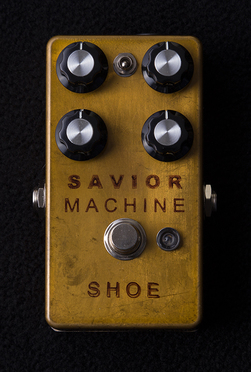SAVIOR MACHINE: OVERDRIVE AND DYNAMIC ENHANCER

The Savior Machine is what can commonly be called a “Transparent” Overdrive. You may have heard this term floated about before. What this means, simply, is the Savior Machine will let the natural sound of your guitar and amp shine through without fundamentally altering their character. This means the pedal will sound different with different guitars or types of pickups and its primary use is to add low to medium gain overdrive or (at lower gain) clean boost and tonal enhancements. The Savior Machine is also a very dynamic overdrive. It is extremely sensitive to pick attack, playing style variations, guitar volume changes, and pickup changes. On most settings, soft playing will still come through the pedal with little to no distortion. As a result, GAIN adjustments on the Savior Machine may be better thought of as sensitivity adjustments.
The Savior Machine is also designed to work well after delays and reverbs. Though it works very well for a wide variety of styles, the pedal was originally designed with Indie Rock and Shoegaze musicians in mind and these styles of music often utilize reverb and delays placed in front of distortion or overdriven amplifiers. By utilizing the Savior Machine’s BASS CUT knob, you can retain a great deal of clarity in these situations (and also restore clarity to muddy pickups or preamps that tend to lose clarity with additional gain).
All in all, you will simply need to play with your pedal to find the sounds that you like, but players in all genres should find good use in this pedal. Given a little time, I am confident you will find the Savior Machine to be an extremely useful and reactive tool to enhance your playing and get your equipment sounding as good as possible in any live, studio, or practice situation.
Controls:
Volume (Top Left): Sets the output level of the pedal
Gain/Sensitivity (Top Right): Controls how easily the pedal overdrives with pick attack.
Headroom Switch (Top Center): Toggles between a softer overdrive setting that easily overdrives and a stiffer and louder boost/compression oriented higher headroom setting intended more for use as a tone shaping tool or overdrive for higher gain amplifiers.
Treble (Bottom Left): Allows the player to turn down high frequencies after the main distortion stage of the pedal.
Bass Cut (Bottom Right): Allows the player to reduce bass response before the main distortion stage of the pedal in order to retain clarity and further adjust the pedal’s gain response.
Bypass (Footswitch): True Bypass switch which removes the overdrive from your signal chain entirely when the LED indicator turns off.
POWER: Please note that SHOE pedals do not run on batteries. You will need a standard 2.1 mm center negative 9V power supply (as used on most pedals) in order to run them. Power consumption is extremely low for all SHOE pedals (less than 5mA and for some pedals even below 1mA) so virtually any pedal power supply of the correct polarity can run more than one SHOE pedal on a daisy chain.
The Savior Machine is also designed to work well after delays and reverbs. Though it works very well for a wide variety of styles, the pedal was originally designed with Indie Rock and Shoegaze musicians in mind and these styles of music often utilize reverb and delays placed in front of distortion or overdriven amplifiers. By utilizing the Savior Machine’s BASS CUT knob, you can retain a great deal of clarity in these situations (and also restore clarity to muddy pickups or preamps that tend to lose clarity with additional gain).
All in all, you will simply need to play with your pedal to find the sounds that you like, but players in all genres should find good use in this pedal. Given a little time, I am confident you will find the Savior Machine to be an extremely useful and reactive tool to enhance your playing and get your equipment sounding as good as possible in any live, studio, or practice situation.
Controls:
Volume (Top Left): Sets the output level of the pedal
Gain/Sensitivity (Top Right): Controls how easily the pedal overdrives with pick attack.
Headroom Switch (Top Center): Toggles between a softer overdrive setting that easily overdrives and a stiffer and louder boost/compression oriented higher headroom setting intended more for use as a tone shaping tool or overdrive for higher gain amplifiers.
Treble (Bottom Left): Allows the player to turn down high frequencies after the main distortion stage of the pedal.
Bass Cut (Bottom Right): Allows the player to reduce bass response before the main distortion stage of the pedal in order to retain clarity and further adjust the pedal’s gain response.
Bypass (Footswitch): True Bypass switch which removes the overdrive from your signal chain entirely when the LED indicator turns off.
POWER: Please note that SHOE pedals do not run on batteries. You will need a standard 2.1 mm center negative 9V power supply (as used on most pedals) in order to run them. Power consumption is extremely low for all SHOE pedals (less than 5mA and for some pedals even below 1mA) so virtually any pedal power supply of the correct polarity can run more than one SHOE pedal on a daisy chain.